Ocean Plastic Cleanup: Unintended Consequences (artificial habitat for mahi-mahi and more)
By David Shormann -- February 18, 2019“Earth stewardship isn’t easy. Sometimes we make the wrong decisions. Sometimes whatever we do has both positive and negative consequences. One wrong decision is The Ocean Cleanup (TOC) project.”
“TOC’s plan … is not manual plastic removal, which allows most creatures to escape. It will instead use purse seines with a minimum mesh size of ⅛ inch (3 mm), capable of trapping microplastics—but also an untold number and variety of sea creatures.”
On a recent boating adventure in the open Pacific, my friends and I came across a section of abandoned fishing net. My first thought was, “Let’s remove it.”
But as I started to pull the net in, I saw a huge mahi-mahi resting in its shade. Also known as dorado or dolphinfish, the mahi-mahi (spooked by my activity) disappeared in a flash. At the same time, small crabs fell off. Barnacles held fast. Small fishes, whose home I had just taken, circled near the boat.
I realized then that I faced a dilemma: should I remove the trash, or give the creatures back their home?
The section of fishing net was large enough to entangle native Hawaiian monk seals, green sea turtles, and spinner dolphins. I felt I should remove it to protect those and similar creatures. But I recognized that doing so would kill others.
Earth stewardship isn’t easy. Sometimes we make the wrong decisions. Sometimes whatever we do has both positive and negative consequences.
One wrong decision is The Ocean Cleanup (TOC) project. The project proposes to use a nearly half-mile long, 10-foot deep mesh wall that passively drifts, gathering plastic waste as it is pushed by the wind. After a certain amount of plastic is collected, a plastic extraction ship arrives. A purse seine nets the trapped plastic for disposal. Everything over 3 mm in size is netted.
Everything.
TOC’s goal is to have 60 systems operating by 2040. The main target area is the “Eastern Pacific Garbage Patch” (EPGP, a.k.a. “Great Pacific Garbage Patch,” or GPGP). That’s a large, hurricane-prone region of circulating currents between California and Hawaii.
If TOC only removed garbage, I’d favor it. But it will also destroy habitat and associated marine life.
Let’s take a closer look at this two-sided issue.
Ocean Plastic as Trash
I removed that piece of fishing net by hand because it was a hazard to boats and larger marine animals. Being on the spot, I could use discretion that suited the situation. But TOC’s plan doesn’t allow that discretion. It’s not manual plastic removal, which allows most creatures to escape. It will instead use purse seines with a minimum mesh size of ⅛ inch (3 mm), capable of trapping microplastics—but also an untold number and variety of sea creatures.
Because of their small size, microplastics have a lot of surface area, relative to their total mass, from which to release potential toxins. TOC’s 146-page environmental assessment references a report by The Joint Group of Experts on the Scientific Aspects of Marine Environmental Protection (GESAMP), whose 2016 reports indicate that plastics may contain toxins harmful to both humans and marine ecosystems.
However, the organization Marine Litter Solutions (referencing the same GESAMP reports) concluded: “It is not considered likely that microplastics will influence the breeding/development success of fish stocks (food security) nor represent an objective risk to human health through tap water (food safety).” GESAMP also concluded that more research is necessary.
While cleaning up trash anywhere is a good idea, the methods employed by TOC are not. Following are what I consider 3 strikes against TOC’s current plan.
Strike One: Ocean Plastic Is Artificial Habitat
Off the US East Coast, a floating seaweed known as Sargassum has been protected since 2003. Why? Because it provides homes for a variety of unique creatures, such as Sargassum fish. It’s also a nursery ground for others, including sea turtles. Mahi-mahi use it for many reasons—as a nursery ground, a hunting ground, protection, and shade, to name a few.
But Sargassum isn’t the only thing that provides those services to mahi-mahi and other marine creatures. Practically anything that floats can—including garbage.
Sargassum doesn’t grow in the Eastern Pacific, so mahi-mahi there use floating plant debris—and trash—as habitat. Recent research shows the EPGP continues to grow. And a 2018 paper in Nature estimated that almost half its trash came from commercial fishing nets, like the one I saw the giant mahi-mahi using as habitat.
Interestingly, increases in the EPGP coincide with increases in mahi-mahi catches. Eastern Pacific countries like Costa Rica, Peru, and Ecuador have had some of the biggest increases. Has the increase in floating trash resulted in increased habitat and therefore higher mahi-mahi populations? Perhaps.
The organization Fish Choice recommends avoiding mahi-mahi caught in the Eastern Pacific using purse seines around floating objects. Why? Most likely because of the significant bycatch (non-target fish and other organisms caught along with the targets) associated with this technique. Unfortunately, while TOC’s environmental assessment addresses sea turtles, it ignores all other bycatch.
Think about it: Every non-trash item TOC nets is bycatch—including mahi-mahi.
Strike Two: The Ocean Cleanup Wall is a FAD
Put an object in the open ocean and it will attract marine life. Fishermen know this, which is why Fish Aggregating Devices, or FADs, are commonly used. Hawaii has dozens, and they are merely yellow buoys with a cable anchored to the bottom.
Surprisingly, Ocean Cleanup’s team seems unsure whether a half-mile long wall on the ocean’s surface will be a FAD. It will. On its FAQ page, TOC claims the speed the wall drifts will prevent fish aggregation. But open ocean fish are used to currents, so this reasoning seems flawed.
The ocean plastic, though it’s not natural, is a habitat. But so is TOC’s wall. And when the purse seine is set, it will catch more than just plastic trash.
Strike Three: The Ocean Surface is Habitat
I won’t spend much time on it here, but a recent article in The Atlantic expertly describes the neuston—an entire ecosystem of small aquatic organisms in the surface level or moving on the surface film of water.
In addition to the neuston, a host of other species migrate vertically daily into and out of the surface layer. Surprisingly, TOC’s environmental assessment mostly ignored these ecosystems. But its mesh wall will certainly upset them.
Summary
As I write this, TOC’s wall and plastic extraction ship are anchored in Hilo, Hawaii, for repairs. Apparently, the open Pacific was more than TOC’s planners were prepared for on their first run to the EPGP. And it’s not even hurricane season.
We have many other ways to reduce plastics and clean up the ocean. Beach cleanups are one. Making a commitment to reduce your use of single-use plastics is another. If TOC put its efforts into beach cleanup and improving trash collection, or helping commercial fishermen find better ways to retrieve lost fishing gear, it could still be part of a huge global plastic-trash reduction, while avoiding the wasteful death of untold numbers of sea creatures.
——————
David Shormann, Ph.D., Marine Chemist and Limnologist, President, DIVE (Digital Interactive Video Education), Houston, TX
Figures
It is likely populations of mahi-mahi and other creatures will drop once Ocean Cleanup’s habitat-removing system is in place. ©2016 Ellie Shormann.
The Ocean Cleanup’s projected goal of removing ocean microplastics by 2050. The main way TOC plans to remove microplastics is by removing larger pieces before they become microplastics (with a diameter of 5 mm or less). While most microplastics will pass under TOC’s mesh wall, its purse seine will capture all microplastics (and marine life) 3 mm or larger in size.
The author cutting fishing line from an entangled Hawaiian green sea turtle. Scientists estimate trash from commercial fishing makes up almost half of the Great Pacific Garbage Patch. ©2016 Ellie Shormann.
While some U.S. fish imports, like Alaskan pollock, are declining, commercial mahi-mahi imports are increasing. Interestingly, the increase in mahi-mahi coincides with the increase in artificial mahi-mahi habitat created by floating plastics. Alaskan pollock, on the other hand, a Bering Sea bottom fish, have not had a similar increase in preferred habitat.
Source: https://www.st.nmfs.noaa.gov/commercial-fisheries/foreign-trade/applications/trade-by-product
Sporting biplane-like wings, this comb jelly and many other fascinating creatures could suffer big losses to TOC’s purse seines. Image ©2019 David Shormann.
Unlike this beach, many are littered with plastic waste. If your beach doesn’t look like this, consider grabbing some garbage bags and a few friends, and help clean it up. Image ©2019 David Shormann.
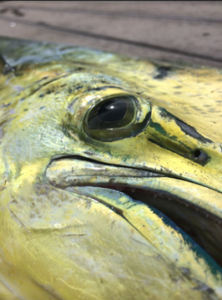
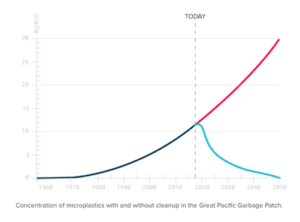
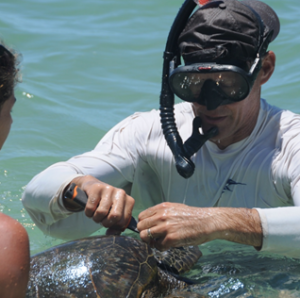
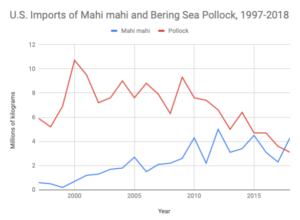
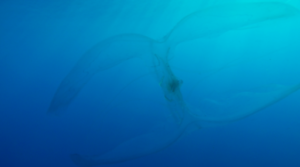
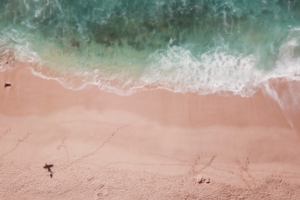
Thoughtful and interesting story of how nature adapts. Thank you!
Turning over leaves, branches, and tree trunks on the forest floor often reveals diverse life underneath. Cover for the ocean, even bits of plastic, attract and promote life (even with risks from plastic).
A few years ago all three debate leagues (Stoa, NSDA, and NCFCA) had ocean topics, so I had the opportunity to research and post articles on various enterprises promoting ocean ecosystems. Many posts: http://economicthinking.org/?s=ocean
Some examples:
• Alabama’s Private Property in the Ocean Policy
http://economicthinking.org/alabamas-private-property-in-ocean/
Property rights for private reefs off the Alabama coast have led to a flourishing fishing industry
• Manmade Reefs for Fisheries: From the Sea of Galilee to Subway Cars in Delaware and Oil Rigs off the Texas Coast
http://economicthinking.org/manmade-reefs-for-fisheries-from-sea-of/
• Oil Platforms as “Towers of Life” Enriching the Oceans
http://economicthinking.org/oil-platforms-as-towers-of-life/
• U.S. Policies for Prosperity from the World’s Oceans
http://economicthinking.org/us-policies-for-prosperity-from-worlds/
• Ocean Plastics: Time for A New Convention?
http://economicthinking.org/ocean-plastics-time-for-a-new-convention/
“…about 90 percent of all the plastic that reaches the world’s oceans gets flushed through just 10 rivers: ”
• Something Fishy About Ocean Catastrophe Narratives
http://economicthinking.org/something-fishy-about-ocean-catastrophe/
• It’s a Big Ocean With Lots of Room for More Fish
http://economicthinking.org/its-big-ocean-with-lots-of-room-for/
• Maybe the Most Valuable Ocean Resource
http://economicthinking.org/maybe-most-valuable-ocean-resource/
Here is Medium article by Seasteading Inst.’s Joe Quirk:
Can Man-Made Floating Cities Save the Ocean?
https://medium.com/world-ocean-forum/can-man-made-floating-islands-save-the-ocean-2663eb3bdccb
One of the most common US Atlantic and Gulf larval species in the plankton is the naked goby, Gobiosoma bosc. In researching them for decades I have found them in sponges, discarded sunken coolers with model train sets, algal mats, grass clumps and roots, bottles, cans, tires, irregularly eroded clays, clam shells, sponges, ghost shrimp burrows, reeds, sunken outboard motors, and sometimes just in flat, muddy ponds. They are usually the most common species in oyster reefs where they use the inside of recently dead oyster shells for attaching their eggs. They are more difficult to collect than a half century ago. A high percentage of ocean ‘environmental fixes’ are actually cosmetic as far as can be determined and likely to have unintended or unexpected consequences.
[…] https://www.masterresource.org/ocean-alarmism/mahi-mahi-ocean-plastic-cleanup/ […]
Nice commentary. A fact left out is the findings of research that shows that microplastics are being eaten by microbes — microplastic disappears entirely as it is consumed (not just accidentally ingested) in the same way that oceanic microbes consumed the crude oil in the Gulf of Mexico.
Once pelagic plastics break down in size to micro sizes, the surface to volume ration makes it possible for the microbes to consume the whole little bit.
I add my personal experience to the concept that anything that floats (or sinks) in the sea become food or a home for some creature. If one wants to increase numbers of fishes, it is only necessary to place an object of almost any kind, into the sea. Floating objects collect small and large travellers either attached of hding in its shade. Offshore of some of the Caribbean islands are vast sand “deserts” with limited numbers of species. But place a rock on the sand — and I have seen this with rocks as small as 8 inches in diameter and they become surrounded by fishes. Sink a boat and you have a tropical reef system. This is true for things we consider to be trash (and offensive): beer bottles, tin cans, lost lobster traps, old refrigerators….anything.
While snorkeling one time, I tried to pick up a discarded beer can only to have it grabbed back by the octopus that had been using it as a “door” to its lair!
A diverse array of environmental initiatives are being implemented to reverse the current degradation trend and promote the sustainable use of marine ecosystems.
Wow, this was such an eye-opening read about the impact of ocean plastic on marine life. I really appreciated how the writer highlighted the importance of addressing this issue and shared some actionable steps that we can take to help. The story about the Mahi Mahi caught in plastic debris was so sad, but it’s a powerful reminder of why we need to take action. Thank you to the writer for shedding light on this important issue